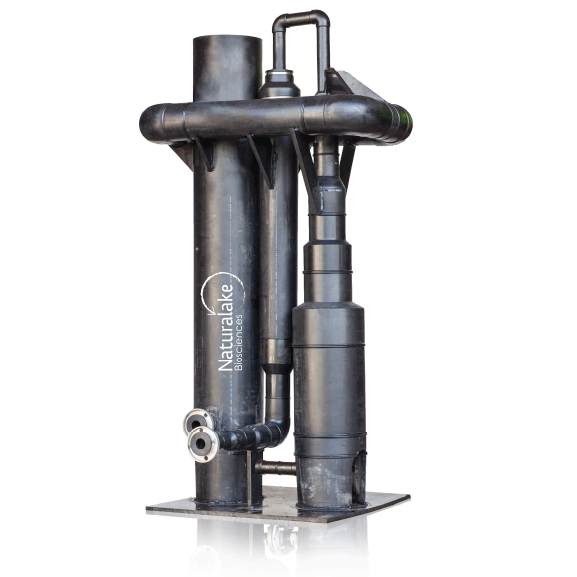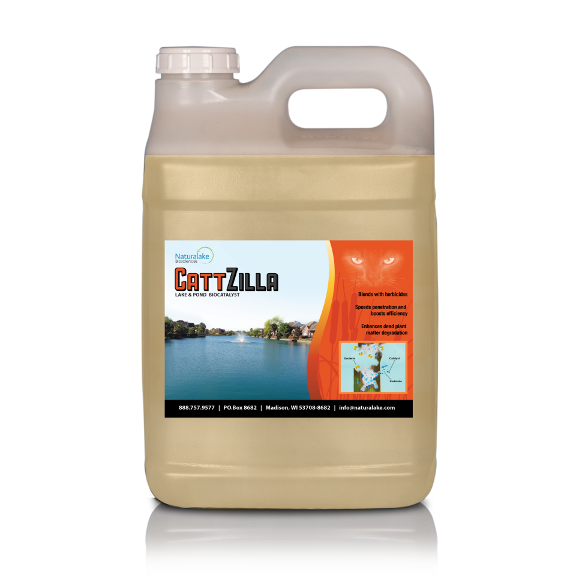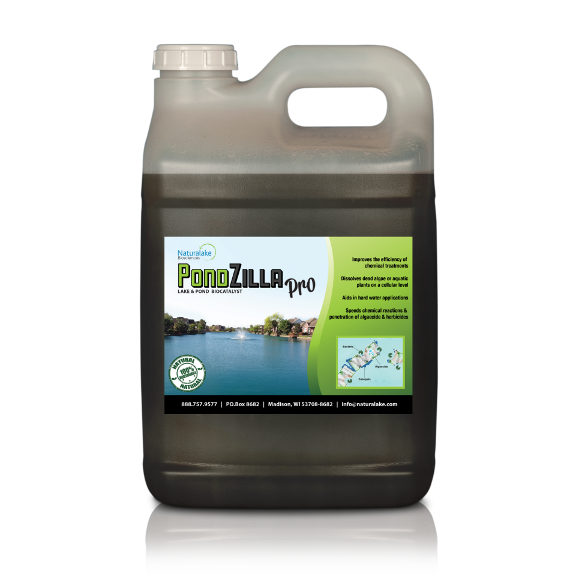
5 Factors Influencing Pond Muck Decomposition and How to Optimize It
by Patrick Goodwin, M.S., CLM & Deborah Lee, Natural Lake Biosciences Senior Microbiologist
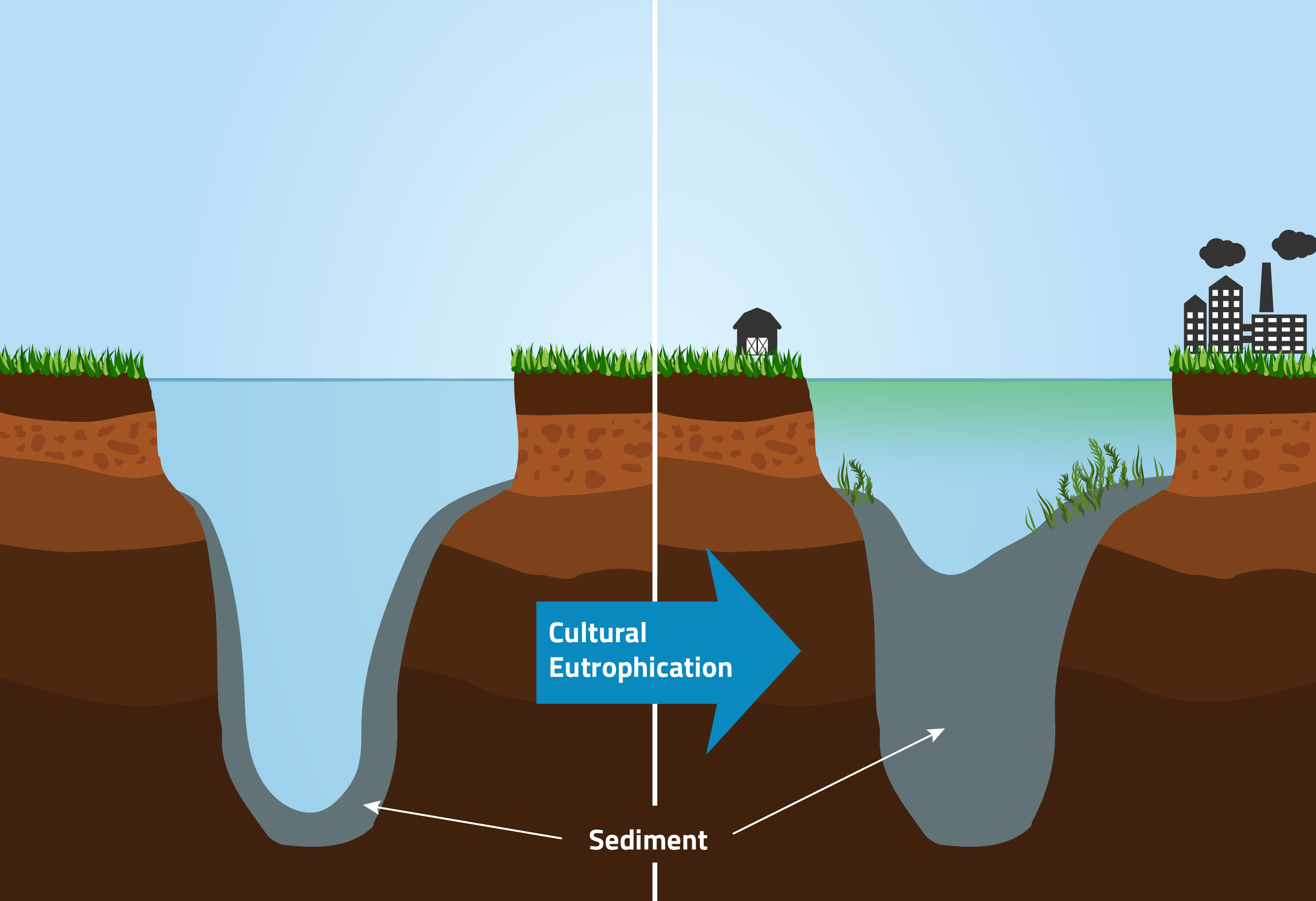
Lake aging, a process by which organic muck accumulates due to incomplete decomposition, leads to reduced storage volumes, water quality impairment, and excessive plant and algae growth. This process is an important aspect of lake management with expensive repercussions. Understanding the types of pond muck present and the factors influencing decomposition can provide valuable insight into optimizing pond muck decomposition rates and restoring balance to a lake, thus reducing the need for chemicals.
Types of Pond Muck
Cole and Weihe (2015) have classified eutrophic lake sediments into three distinct categories:
Copropel muck (Gyttja):
This muck consists of a matrix of humus material, fine plant fragments, algal remains, grains of quartz and mica, diatom frustules, aquatic invertebrate exoskeleton fragments, and spore and pollen relics. Its color ranges from gray to dark brown. Copropel sediments often are well-oxygenated and have a near-neutral pH.
Sapropel muck:
This muck forms when bottom deposits undergo periods of anoxia. It is a glossy black, rather watery material, lacking the structure of Copropel. Sapropel muck emits the rotten-egg odor of H2S, contains the marsh gas methane (CH4), and owes its shiny black color to ferrous sulfide. Often, sapropel overlies Copropel, reflecting long-term changes in the oxygen regimen. Lakes receiving organic pollutants often have a few centimeters of sapropel overlying compacted dark brown Copropel. Sapropel sediments usually are very limited in benthic macro-invertebrates due to anoxic waters and released toxic gases.
Dystrophic muck:
This muck is much like Copropel sediments but has abundant acid humus and fibrous plant materials. The brown humus of dystrophic sediments has a carbon/nitrogen ratio greater than 10, while Copropel has a lesser C/N proportion. Dystrophic sediments are common in areas with high amounts of littoral vegetation.
A typical pre-treatment muck sample was taken with Eckman dredge.
Factors Influencing Muck Decomposition and How to Optimize it
Oxygen
Reed (1979) found that organic matter decomposes more slowly under anaerobic (low oxygen environments) than aerobic conditions. During summer stratification, the breakdown occurred more slowly at greater depths in a lake and was attributable to low dissolved oxygen levels.
When oxygen is present, bacteria can oxidize organic matter (combine it with oxygen). Because organic matter always contains carbon and hydrogen, oxidation produces carbon dioxide and water. A generic formula for this process is C6H12O6 + 6O2 → 6H20 + 6CO2. When oxygen concentrations fall below 1.5-2 mg/L, the rate of aerobic oxidation reduces significantly. Anaerobic bacteria can oxidize organic matter without using oxygen, but the end products include toxic compounds such as hydrogen sulfide (H2S), ammonium (NH4), and methane (CH4). The process of anaerobic decomposition is much slower than aerobic decomposition.
More oxygen in the overlying waters allows more oxygen to migrate downward into the muck layer, enabling chemical and biological oxidation to occur. Mixing devices like bottom diffusers, surface aerators, or fountains can increase oxygen levels to some degree. However, they are limited in how much oxygen they can add and sustain over time. Since oxygen addition from mixing devices is driven by wind speeds and
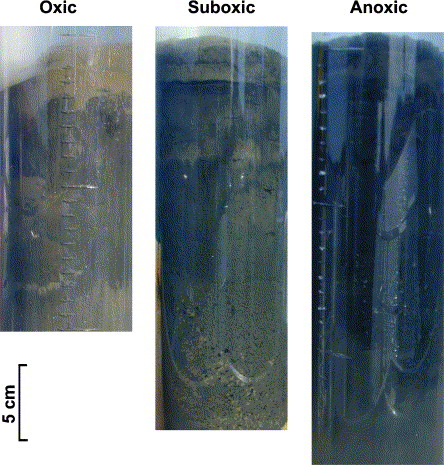
Virtasalo, Joonas J., et al. (2005) “Sea bottom anoxia in the Archipelago Sea, northern Baltic Sea—implications for phosphorus remineralization at the sediment surface.” Marine Geology 224.1-4: 103-122.
temperature, not mixing intensity or bubbles, it is common to have less than 2 mg/L on average over the muck layer for most of the year. The most effective technology to oxidize muck is Oxygenation Saturation Technology™ (OST)®, which provides an oxygen blanket over and into the muck. OST can maintain well above 8 mg/L 24-7, 365 days a year. By not mixing, oxygen can build up over the sediments, effectively penetrating downward and increasing the amount of muck to be oxidized.
Invertebrates
Leaf-shredding invertebrates, like dragonflies and water bugs, preferentially colonize and feed on microbially conditioned organic muck and may contribute significantly to leaf breakdown. A rich community of benthic invertebrates almost always demonstrates rapid plant and detritus material breakdown rates.
Schäfer et al. (2012) and Link et al. (2022) found that leaf litter breakdown was significantly slower in waters receiving pesticides than in natural watersheds, partly due to low macroinvertebrate densities. Therefore, maintaining a diverse benthic invertebrate community can be achieved by reducing chemical use such as copper and alum, pesticide runoff, and maintaining adequate oxygen levels (> 8 mg/L).
Toxic Chemicals
Pesticides and metals can potentially have acute and chronic toxicity to invertebrates and microbes, leading to slower organic matter decomposition. Gray & Ward (1983) found that harsh chemical flocs, like alum, depositing on leaf surfaces inhibited microbial and invertebrate colonization and were the main factor responsible for reduced leaf breakdown. Additionally, copper was noted to inhibit microbial activity even at low concentrations (Leland & Carter, 1985). To reduce nutrients and improve water quality, natural products, like MetaFloc and Water Column Clarifier, are the better alternatives as they do not pose toxicity issues.
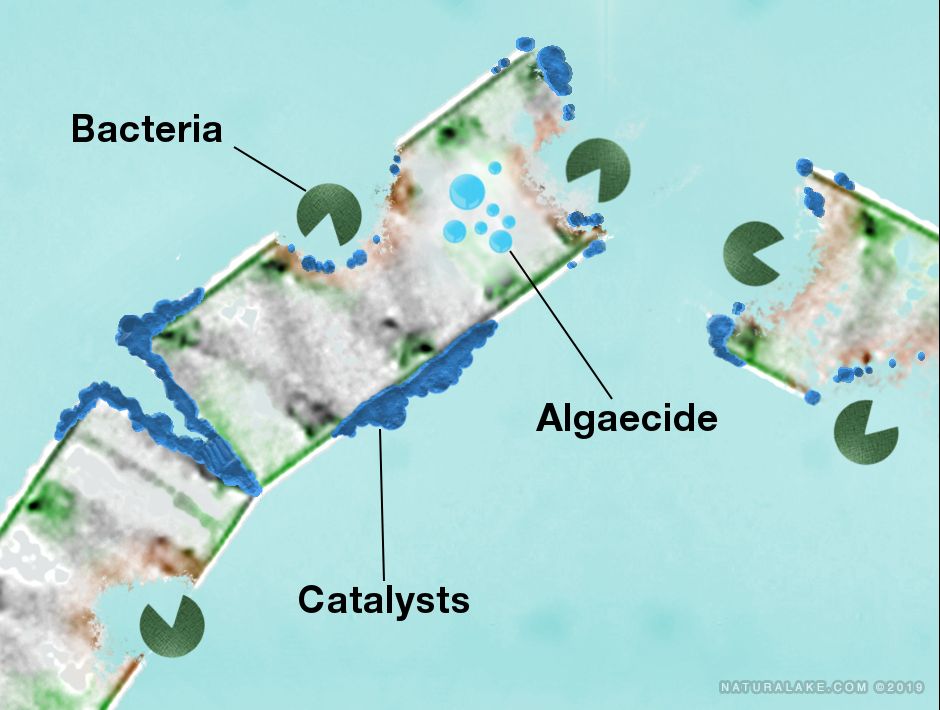
Organic Matter Composition
The type of organic debris entering a lake also impacts decomposition rates and the microbial community and enzymes that should be used. For example, Petersen (1984) found that non-woody plant leaves broke down significantly faster than woody plant leaves. The least-square means over all sites were 0.0109 day-1 for nonwoody plants and 0.0035 day-1 for woody plants. The groups with the fastest breakdown rates included submerged and floating macrophytes.
On a molecular level, organic matter high in structural polysaccharides, cellulose, and hemicellulose of plant cell walls are physically and chemically bound to lignin, forming lignocellulose. This resistant complex renders cellulose and hemicellulose less accessible to enzymes and microbial decomposition. However, Natural Lake University has bio-engineered microbes to degrade all types of organic matter, even woody lignocellulose. For example, Cattzilla is used for high-lignocellulose plants, while PondZilla Pro is better suited for algae and submerged plant degradation. Both biocatalysts increase algaecide and herbicide efficacy while helping to degrade organic matter. Pairing the right microbial product with the right organic matter can drastically improve decomposition and water quality in the long term, all while reducing chemical use.
Microbial Community
Organic matter decomposition rates depend on the microbial community present, which is constantly changing (Ren et al., 2016). Over time, microbial succession will happen as organic matter quality or content changes or if the environment changes from factors outside the pond/lake, such as heavy rain events, pesticide runoff, chemical treatments, etc. Such outside factors or any environmental stress can shape the direction of species present, which can alter the type and rate of organic matter broken down (Ren et al., 2016) and select for chemical-tolerant species.
One way to ensure a desirable microbial community is maintained that will have the fastest organic matter degradation rate is to use MuckBiotics; a tableted probiotic that speeds the digestion of organic compounds and nutrients. When applied, the probiotic tablets sink into the muck layer and activate. This process infuses muck with beneficial microorganisms, biostimulants, and vitamins for optimal degradation. The bacteria, introduced from the tablets and naturally occurring, produce enzymes that break down complex proteins, starches, and lipids into amino acids, simple sugars, and fatty acids which are rapidly used in bacterial metabolism. The muck compacts, dehydrates, and washes out to varying degrees, resulting in decreased muck levels, reduced nitrogen, and less available phosphorus. Muckbiotics are engineered to work in both low-oxygen and high-oxygen environments (facilitative). However, they will be more efficient in high-oxygen environments and not produce offensive gases like hydrogen sulfide. MuckBiotics are a low-cost and environmentally friendly option for treating muck with significant organic content.
References
Bärlocher, F., & Schweizer, M. (1983). Effects of leaf size and decay rate on colonization by aquatic hyphomycetes. Oikos, 41(2), 205–210. https://doi.org/10.2307/3544265
Benfield, E. F., & Webster, J. R. (1985). Shredder abundance and leaf breakdown in an Appalachian Mountain stream. Freshwater Biology, 15, 113–120.
Cole, G. A., & Weihe, P. E. (2015). Textbook of limnology. Waveland Press.
Gray, L. J., & Ward, J. V. (1983). Leaf litter breakdown in streams receiving treated and untreated metal mine drainage. Environment International, 9, 135–138.
Leland, H. V., & Carter, J. L. (1985). Effects of copper on production of periphyton, nitrogen fixation and processing of leaf litter in a Sierra Nevada, California, stream. Freshwater Biology, 15, 155–173. https://doi.org/10.1111/j.1365-2427.1985.tb00189.x
Link, M., Schreiner, V. C., Graf, N., Szӧcs, E., Bundschuh, M., Battes, K.P., Cîmpean M., Sures, B., Grabner, D., Buse, J., & Schӓfer, R.B. (2022). Pesticide effects on macroinvertebrates and leaf litter decomposition in areas with traditional agriculture. Science of the Total Environment, 828, 154549.
Petersen, R. C. (1984). Detritus decomposition in endogenous and exogenous rivers of a tropical wetland: With 6 tables in the text. Internationale Vereinigung für theoretische und angewandte Limnologie: Verhandlungen, 22, 1926–1931. https://doi.org/10.1080/03680770.1983.11897595
Reed, F. C. (1979). Decomposition of Acer Rubrum Leaves at three depths in a eutrophic Ohio lake. Hydrobiologia, 64, 195–197. https://doi.org/10.1007/BF00020519
Ren, Y., Niu, J., Huang, W., Peng, D., Xiao, Y., Zhang, X., Liang, Y., Liu, X., & Yin, H. (2016). Comparison of microbial taxonomic and functional shift pattern along contamination gradient. BMC Microbiology, 16, 110. https://doi.org/10.1186/s12866-016-0731-6
Schäfer, R. B., Von Der Ohe, P. C., Rasmussen, J., Kefford, B. J., Beketov, M. A., Schulz, R., & Liess, M. (2012). Thresholds for the effects of pesticides on invertebrate communities and leaf breakdown in stream ecosystems. Environmental Science & Technology, 46, 5134–5142. https://doi.org/10.1021/es2039882
Webster, J. R., & Benfield, E. F. (1986). Vascular plant breakdown in freshwater ecosystems. Annual Review of Ecology and Systematics, 17, 567–594. https://doi.org/10.1146/annurev.es.17.110186.003031
About the Authors
Patrick Goodwin, M.S., CLM, serves as a Water Resource Specialist at Natural Lake Biosciences, bringing over a decade of expertise in water resource management. He specializes in collecting data to assess nutrient loading and its impacts on algal blooms and water clarity. With a proven track record of restoring numerous water bodies, Patrick is recognized as an authority in implementing oxygenation and circulation techniques.


Deborah Lee, a Senior Microbiologist at Natural Lake Biosciences, has dedicated 11 years to studying microbial communities and their interactions with nitrogen and ammonia in aquatic ecosystems. Her extensive research on aquatic plants and algae in the lab has spurred numerous product advancements and enhanced formulations. Deborah’s profound knowledge in microbiology, alongside her specialization in algae and aquatic plants, is essential to our success.

